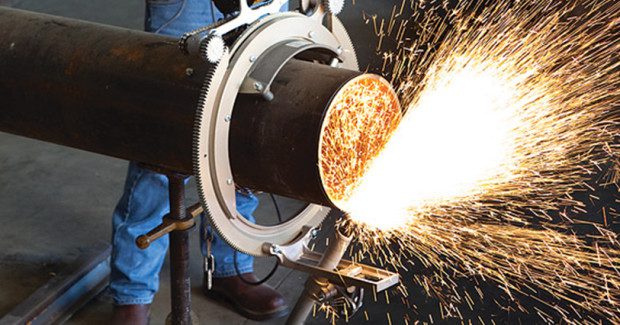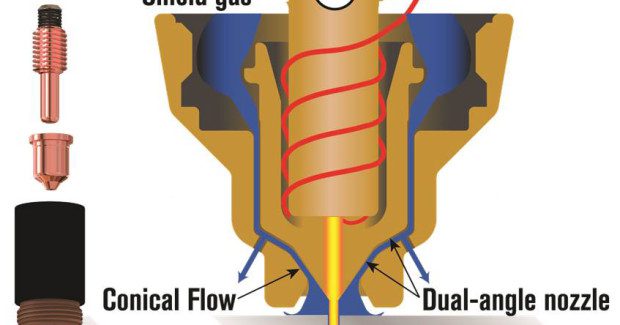Beware of Bad Bargains
Watch out for artificially low prices on aftermarket plasma torch consumable parts. Before you buy, it is important to be aware of a few of the poor performance issues and risk of torch damage that your shop will experience if you purchase imitation consumables.
Posted: August 1, 2014
The major manufacturers of plasma cutting equipment have been selling a wide variety of these systems since the early 1960s. In about 1985, air plasma technology started to improve rather rapidly with newer power supply technologies and some advanced torch developments. This led to the widespread use of air plasma cutting systems around the globe for both hand-held and mechanized cutting applications.
As with any type of product, when sales volumes got high many entrepreneurs saw the opportunity to manufacture and sell replacement parts for these systems, essentially cashing in on the design efforts and engineering work of someone else. In the plasma cutting industry there are a few suppliers of aftermarket copies of torch consumable parts. Most of these suppliers simply copy the nozzle and electrode designs already being used in the most popular system models, meaning they incur no research or engineering expenses and, in most cases, no costs for reliability or quality testing of components – all of which allows them to artificially keep their prices below the genuine consumables made by the original torch manufacturers.
Many of the newer air plasma torches use advanced designs manufactured through patented proprietary techniques that dramatically improve both consumable life and cut quality. One good example of this is our own Duramax torch that is used with our Powermax family of systems. This torch utilizes a patented spring electrode design combined with Conical Flow technology in the nozzle and shield assemblies, using patented consumable parts produced by proprietary manufacturing processes at our facilities in New Hampshire and shipped inside clearly identifiable packaging that is sold through our worldwide distribution network.
http://youtu.be/wHAuq0ntUD4
Jim Colt walks through maintaining a torch and inspecting plasma cutting consumables.
In the last few years there has been an influx of online suppliers purportedly selling genuine parts for our newest torch at online outlets like Amazon and Ebay. While some actual genuine parts are being sold through authorized distribution channels, many counterfeits are being shipped inside nearly-identical packaging that includes trademarks, part numbers and even patent numbers, all produced by Chinese factories. At first glance, this deceptive packaging and the imitation consumables it contains look so convincingly real that we can’t even tell the difference between the genuine and the fake product. We must put them under a microscope.
These counterfeits are often sold at prices about 30 percent or more below the price of the genuine parts. As we pursue copyright and patent infringing suppliers through our legal team, it is important for buyers to be aware of a few of the performance issues that their shops will experience if they happen to (knowingly or unknowingly!) purchase some of these imitation consumables.
An air plasma torch is a precision device that takes advantage of some theories and laws involving high temperature physics. Without getting into too much detail, the torch ionizes regular compressed air, adds DC energy to the conductive ionized air stream to increase its temperature to over 20,000 deg F, then forces this high temperature plasma through a copper nozzle orifice to increase its energy density and velocity. This high temperature, high velocity arc is then used to very efficiently cut metals at high speeds with very low operating cost in both hand-held and precise mechanized applications.
Think about 20,000 deg F passing through a small copper orifice (certain blends of copper are used for efficient heat transfer and torch cooling) that melts at less than 1,100 deg F. Process engineers have finely tuned the consumable parts used in this process to survive for thousands of feet of metal cutting by pushing the laws of physics to the limits. Extreme accuracy in manufacturing, in proper materials, and in repeatable and tight parts all stack up tolerances that are absolutely necessary to make these consumables last so that the torch can cut with consistency day after day.
While genuine consumables manufacturers are reluctant to release details of the materials used to produce their nozzles, electrodes and swirl rings, they are very clear of its key importance in ensuring that all of the cutting energy and heat is applied to the cutting process instead of overheating the internal torch components. For example, a specially produced and accurately sized (for the amperage level) hafnium slug is bonded to a special blend of copper on each electrode design for our torches. Without our proprietary techniques, the electrode life and the potential for internal torch arcing and damage rises dramatically.
Nozzles are machined from yet another type of pure copper and are held to extremely tight tolerances for production parts. The shape of the nozzle, in conjunction with the shape of the shield, is used to inject secondary air flow around the perimeter of the arc on our torches, a technique that further increases the energy density of the cutting arc, thereby improving cut quality as well as increasing nozzle orifice life. The stacked up tolerances of the electrode, swirl ring, nozzle and shield in these torches are held to critical dimensions in order to make the technology perform to its design specs under tough industrial conditions. And when I say critical dimensions and tight tolerances, I mean it. Many of our consumables are machined to tolerance levels eight times narrower than a human hair. Think about that.
Needless to say, imitation aftermarket consumable parts are designed and built only with quick profit in mind. They tend to use the lowest cost materials and are manufactured with techniques that focus primarily on rapid production instead of quality and tight tolerances. Most reports we have received from users of these imitation aftermarket parts indicate that these counterfeits were bought because the price was low and they appeared to be genuine. But the 30 percent or more initial savings on the purchase proved to be a moot point based on poor cut quality, as well as consumable life that fell far short of the genuine parts. And that’s not all, because these counterfeits not only impact cut quality and consumable life, they can also do serious damage to your system as the risk of internal torch damage increases.
Cost savings? The last time I calculated the cutting cost when cutting ½ in steel on my own home shop CNC plasma, my Powermax consumable parts component calculated out to approximately ½ cent per foot of cut. Assuming these aftermarket consumables cut as well and lasted as long as the genuine parts (which they don’t!), then your savings if these parts were 30 percent less expensive would be roughly 1/8 of a penny lower per foot of cut. In reality, these imitations, though priced 30 percent lower, do not last as long and do not cut as well as the genuine parts. They ultimately end up costing far more to use – with the added risk of torch damage. Not a good idea.
Besides these import parts being poor performers that risk torch damage, they also often infringe on the intellectual property rights (patents) and copyrights of the genuine manufacturers. If you suspect aftermarket parts – generally, but not always, identified by abnormally low online prices – please contact the genuine manufacturers to determine if they are truly the real thing or if there is an issue with your plasma system.

















